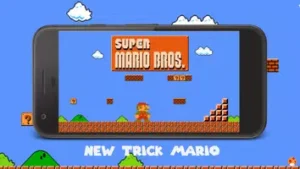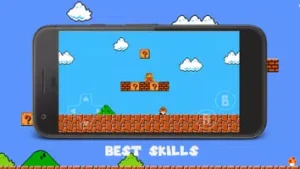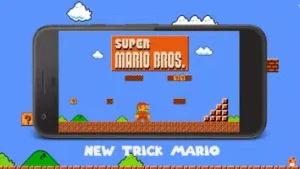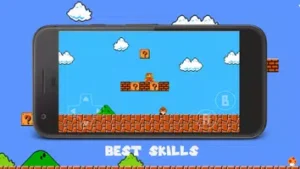Super Mario Bros. has expanded into various media, including animated series, merchandise, and even a feature film, further solidifying its place in popular culture.
As new generations of gamers continue to embrace Mario’s adventures, the legacy of this iconic character remains vibrant and influential, inspiring countless titles and innovations in the gaming industry.
The Birth of a Legend
This vision culminated in the creation of Super Mario Bros., a game that not only revitalised the gaming industry but also established Mario as a beloved icon.
The innovative gameplay mechanics, coupled with vibrant graphics and memorable music, captivated players and set a new standard for future video games.
In Donkey Kong, the character was called Jumpman. He later changed his name to Mario, after Nintendo’s warehouse landlord.
Miyamoto created a side-scrolling adventure that broke away from the static screens of previous platformers in collaboration with composer Koji Kondo, whose infectious tunes became synonymous with Mario. Super Mario Bros.
introduced players to the Mushroom Kingdom, a place full of Goombas, floating platforms, and warp pipes, when it was first released in Japan in 1985 and then worldwide in 1987.
Gameplay Mechanics: A Blueprint for Innovation
Super Mario Bros.’s intricate design and precise controls transformed gameplay. Mario moved intuitively but skilfully, running, leaping, and crushing foes.
The game’s scrolling screen, which was new at the time, gave players the impression that there was always more to discover.
The 32 levels were carefully crafted to introduce ideas like power-ups and secret blocks without the need for tutorials, allowing players to learn by doing.
Strategic depth was introduced with the addition of power-ups like the Fire Flower, which allowed fireball assaults, and the Super Mushroom, which caused Mario to expand.
Invisible blocks and warp zones were examples of secrets that promoted replayability. Players were challenged yet kept interested by the game’s difficulty curve, which increased from easy slopes to intimidating castles.
The Rise to Fame: Saving an Industry
With more than 40 million copies sold worldwide, Super Mario Bros. was a commercial success. When it was combined with the NES, it came to represent home gaming and helped Nintendo take 90% of the market by 1989.
With participants exchanging advice and vying for high scores, it swiftly established itself as a social mainstay after receiving plaudits from critics for its originality and refinement.
The industry was revitalised by the game’s popularity, which also made Nintendo a leader and set standards for excellence.
In the 1990s, it also gave rise to a competition with Sonic the Hedgehog from Sega, which fuelled the “console wars” that spurred innovation.
Evolution of the Series: From Pixels to 3D
The Super Mario series saw significant change as each new game added ground-breaking elements:
- An overworld map, themed levels, and new power-ups like the Tanooki Suit were all introduced in Super Mario Bros. 3 (1988).
- When Super Mario World (1990) made its SNES debut, it had Yoshi, hidden exits, and more adventure.
- Super Mario 64 (1996): Pioneered analogue stick controls and open-ended courses, marking the Nintendo 64’s transition to 3D.
- Super Mario Galaxy (2007) redefined platforming with the use of spherical mechanics and cosmic themes.
- Super Mario Odyssey (2017): Presented expansive, explorable kingdoms and the sentient hat Cappy.
Each game ensured relevance throughout generations by striking a balance between innovation and the fundamental principles that made Mario immortal.
Cultural Impact: Beyond the Screen
Mario’s impact goes much beyond video games. He appeared in cartoons, a 1993 live-action movie that received negative reviews, and the highly successful animated film The Super Mario Bros.
Movie, which made over $1 billion in 2023. Toys, apparel, and theme parks such as Super Nintendo World witness to his popularity throughout the world.
One of the most well-known soundtracks in music is that of Koji Kondo, especially the overworld theme. Mario’s reputation as a pop culture figure has been cemented by the celebration, memorisation, and parody of his visage.
Legacy and Influence: Shaping the Future of Gaming
Super Mario Bros.’ lasting appeal and influence on the industry are clear indications of its legacy.
It created the platformer genre and served as an inspiration for popular franchises like Crash Bandicoot and Sonic.
Its design tenets of rewarding exploration, precise controls, and increasing complexity remain fundamental.
The series’ longevity is guaranteed by its versatility. From VR experiences to smartphone games like Super Mario Run, Mario consistently adopts new technology while maintaining his allure.
Mario is introduced to new audiences through Nintendo’s approach of re-releasing oldies on platforms like the Switch Virtual Console.
Conclusion
Mario is still a representation of happiness and inventiveness even forty years after his debut. In addition to saving an industry, Super Mario Bros. revolutionised interactive entertainment.
A plumber from the Mushroom Kingdom may remain king in a world that is changing quickly because of the series’ unchanging excellence and ongoing innovation.
Mario’s influence survives as gaming changes, demonstrating the value of play and inventiveness.








